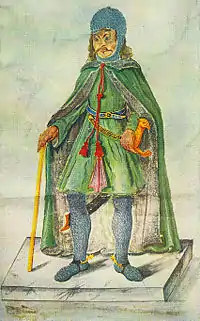Clan Russell
Clan Russell is a Scottish armigerous clan, with claimed origins in Normandy. It has ancestral ties to the English Dukes of Bedford, and has numerous descendants in Great Britain and America.
| Clan Russell | |
|---|---|
| Ruiseal | |
 Crest: A dexter hand holding a skene dubh and on the point thereof a pair of balances, all Proper. | |
| Motto | Virtus sine macula. (Virtue without a stain[1]) |
| Profile | |
| Region | Lowlands and Highlands |
| District | Perth and Kinross, Clackmannanshire and Aberdeenshire |
| Clan Russell has no chief, and is an armigerous clan | |
| Historic seat | Aden in Aberdeenshire, various other locations in Scotland |
| Last Chief | Baron Rozel |
History
Origins of the clan

Scottish author George F Black believed the surname Russell may be derived from roux which means red.[2] Other writers claim it to be derived from the Norman place name de Rosel. The name was commonly found among the Anglo-Normans as the personal name of Rufus (from Le Roux a nickname for someone with red hair).[2] Between 1164 and 1177 Walter Russel witnessed a charter in favour of Paisley Abbey.[2] Mentioned in a charter of about 1180 is John, son of Robert Russel of Duncanlaw.[2] In 1259 Robert Russel witnessed a deed relating to the lands of Threipland.[2]
Wars of Scottish Independence
In 1296 Robert Russel appears on the Ragman Rolls giving homage to Edward I of England.[2] Historian William Anderson stated that the name of Russel came to Aberdeenshire with one Rozel who was an English baron who fought at the siege of Berwick and the Battle of Halidon Hill in 1333.[2] Rozel subsequently settled in Scotland and obtained the estate of Aden.[2] His family was styled 'Russel of that Ilk'.[2]
17th, 18th and 19th centuries
Patrick Russel was married to a sister of Archbishop Sharp and in 1680 he purchased the lands of Moncoffer in Banffshire. From him descend the Scottish Barons of Aden, Aberdeenshire.[2] The Russel of Ashiesteel family in Selkirkshire were particularly distinguished in military service.[2] Between 1756 and 1767 Colonel William Russel of Ashiesteel was adjutant general of the army of Madras and served under General Lord Clive.[2] His son was Major General Sir James Russel who also served in India and commanded a brigade of cavalry at the Battle of Mahidpur.[2]
Alexander Russell was an eminent doctor and naturalist and in 1756 published a Natural History of Aleppo.[2]
In England, the descendants of Rufus became Dukes of Bedford.[2] The third son of the sixth Duke was John Russell who studied at the University of Edinburgh where he greatly admired the independent and democratic philosophy of the Scots.[2] In politics he was the architect of the first Reform Act 1832 and served as Prime Minister of the United Kingdom.[2] He was created Earl Russell in 1861.[2] His grandson was Bertrand Russell who was one of the great philosophers of the twentieth century.[2]
Castles
- Ashiesteel House, three miles west of Galashiels in the Scottish Borders is a mansion that incorporates a tower house dating from the seventeenth century.[3] It was owned by the Russles but was later home to Sir Walter Scott who wrote several of his works there.[3]
- Banff Castle, east of Banff, Aberdeenshire was originally owned by the Clan Comyn but later passed to the Sharps and then the Russells.[3] Little remains of the original castle and a Robert Adam mansion was built there in the eighteenth century.[3]
- Montcoffer House, two miles south of Banff, is a mansion dating from 1670.[3] The Russels sold it to the Duff Duke of Fife in 1750.[3] It was remodelled in 1825.[3]
- Aden House, a mansion ten miles west of Peterhead in Aberdeenshire, is now a ruinous shell that dates from 1832.[3] The present building had replaced an old castle.[3] The Russells sold the house and most of the estate it in 1937. It is said to be haunted by the ghost of one of the daughters of one of the owners.[3]
- Blackhall Castle, was two miles west of Banchory in Aberdeenshire and was a strong castle but nothing now remains.[3] It was held by the Russells and then by the Clan Hay.[3]
References
- Fairbairn, James; Fox-Davies, Arthur Charles (1892). Volume 1 of Fairbairn's Book of Crests of the Families of Great Britain and Ireland. Edinburgh: T. C. and E. C. Jack. p. 91. Retrieved 5 October 2015.
- Way, George and Squire, Romily. (1994). Collins Scottish Clan & Family Encyclopedia. (Foreword by The Rt Hon. The Earl of Elgin KT, Convenor, The Standing Council of Scottish Chiefs). pp. 453.
- Coventry, Martin. (2008). Castles of the Clans: The Strongholds and Seats of 750 Scottish Families and Clans. pp. 509. ISBN 978-1-899874-36-1.